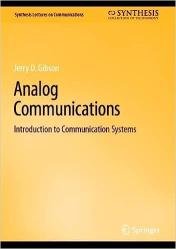Analog Communications: Introduction to Communication Systems
- Добавил: literator
- Дата: 12-03-2023, 12:44
- Комментариев: 0
 Название: Analog Communications: Introduction to Communication Systems
Название: Analog Communications: Introduction to Communication SystemsАвтор: Jerry D. Gibson
Издательство: Springer
Год: 2023
Страниц: 102
Язык: английский
Формат: pdf (true)
Размер: 10.1 MB
This book develops the basic concepts in understanding Analog Communications. Beginning with coverage of amplitude modulation, including the time and frequency domain representations of double sideband, single sideband, and vestigial sideband modulation, and introduces the student to the fundamental ideas of quadrature amplitude modulation, frequency division multiplexing, and digital communications using on-off keying. The author continues with additional discussion and coverage of the time and frequency domain representations of frequency and phase modulation, including bandwidth calculations, and the use of frequency shift keying, phase shift keying, and differential phase shift keying for the transmission of digital information.
Contents include applications and further analyses of the effects of channel noise on amplitude, phase, and frequency modulation performance based on input versus output signal to noise ratios and some system comparisons are discussed.
A common lay definition of the verb to modulate is “to tune to a certain key or pitch.” In amplitude modulation, this is precisely what is being done; namely, the information to be transmitted, hereafter called the message signal, is moved to another location in the frequency spectrum. This relocation is easily accomplished by multiplying the message signal by a pure sinusoid; however, one may wonder why we wish to modulate the message signal at all. A little thought produces several excellent reasons.
First, the original frequency content of many signals that we wish to transmit overlap. For example, speech signals fall in the range 0–4000 Hz, music contains frequencies in the range 0–20,000 Hz, and television video signals originally occupy the band 0–5 MHz. If several of these signals were transmitted simultaneously over the same medium (cable, wire pairs, etc.) without modulation, they would interfere with each other and unintelligible signals would be received. Modulation allows us to send these signals simultaneously without interference by moving each signal to a different frequency band during transmission. A second reason for relocating message signals in frequency is that there are numerous sources of noiselike signals at low frequencies, such as car ignitions, electric lights, and electric motors. A third reason relates to antenna size for free-space transmission. For the efficient radiation of electromagnetic waves, the antenna size should be proportional to or larger than the transmitted wavelength. If the frequency to be transmitted is 5000 Hz, the wavelength is 60,000 meters! Of course, an antenna anywhere near this size is impractical. There are additional reasons for using various types of modulation, and they will become evident as the development progresses.
The discussion of amplitude modulation (AM) begins with a treatment of AM double-sideband suppressed carrier (AMDSB-SC) systems in Sect. 1.2. The development includes sketches of a typical time-domain AMDSB-SC waveform as well as its frequency content, a discussion of coherent demodulation, and a derivation of the effects of frequency and phase errors in coherent demodulation. Conventional AM (i.e., AMDSB-transmitted carrier) is presented in Sect. 1.3, which includes envelope detection, sketches of the time-domain waveform and its Fourier transform, and a discussion of percent modulation and efficiency. In Sects. 1.4 and 1.5 we develop single-sideband and vestigial sideband AM, respectively. Time-domain waveform expressions and their Fourier transforms, demodulation of the received signals, frequency and phase errors in coherent demodulation, and the selection of filter shape are addressed. Superheterodyne systems are discussed in Sect. 1.6, which includes such topics as the choice of intermediate-frequency (IF) filter center frequency and bandwidth, image stations and radio-frequency (RF) filter bandwidth, and tuning range. AM radio examples are given. Quadrature amplitude modulation is defined in Sects. 1.7 and 1.8 we introduce the concept of frequency-division multiplexing and how it is used in communication systems. Binary and multilevel amplitude shift keying (ASK) are considered in Sect. 1.9, with sketches of time-domain waveforms and a discussion of demodulation methods.
Скачать Analog Communications: Introduction to Communication Systems
Внимание
Уважаемый посетитель, Вы зашли на сайт как незарегистрированный пользователь.
Мы рекомендуем Вам зарегистрироваться либо войти на сайт под своим именем.
Уважаемый посетитель, Вы зашли на сайт как незарегистрированный пользователь.
Мы рекомендуем Вам зарегистрироваться либо войти на сайт под своим именем.
Информация
Посетители, находящиеся в группе Гости, не могут оставлять комментарии к данной публикации.
Посетители, находящиеся в группе Гости, не могут оставлять комментарии к данной публикации.
